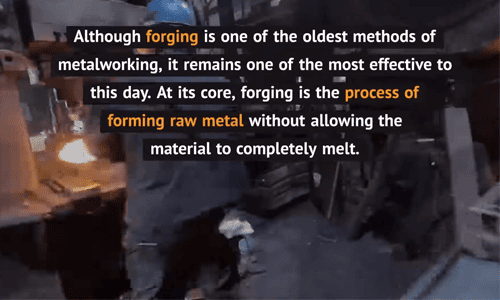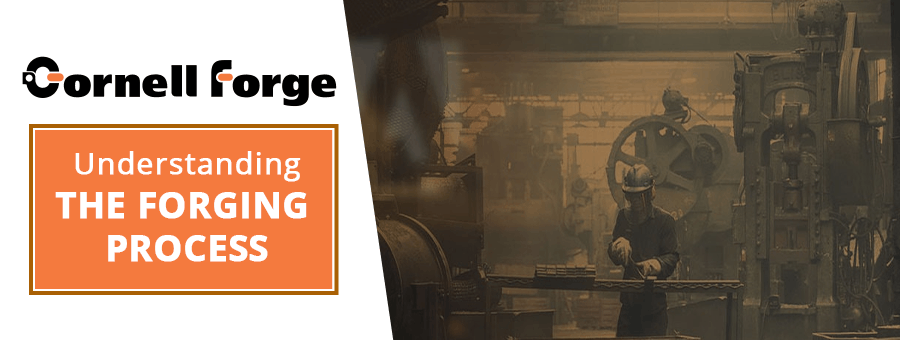
Although forging is one of the oldest methods of metalworking, it remains one of the most effective to this day. At its core, forging is the process of forming raw metal without allowing the material to completely melt. The metal remains in a solid state while an operator performs any combination of forming techniques such as hammering, rolling, or pressing. While there are many variations of forging—each with their own distinct advantages—most involve heating the workpiece to very high temperatures to facilitate these shaping processes.
Compared to casting or other metalworking techniques, forging yields the most desirable physical characteristics—including a very high degree of tensile strength—at an attractive price-point. These beneficial properties primarily come from changes to the metal’s grain. Since the material is never melted, the percussive or compressive forces applied during forging force the grain to follow the flow of the finished product. This creates components that are far stronger than their machined and casted counterparts.
Cornell Forge makes these advantages accessible to clients across industries, offering a full range of skilled forging services that meet the needs of myriad applications.
The Forging Process
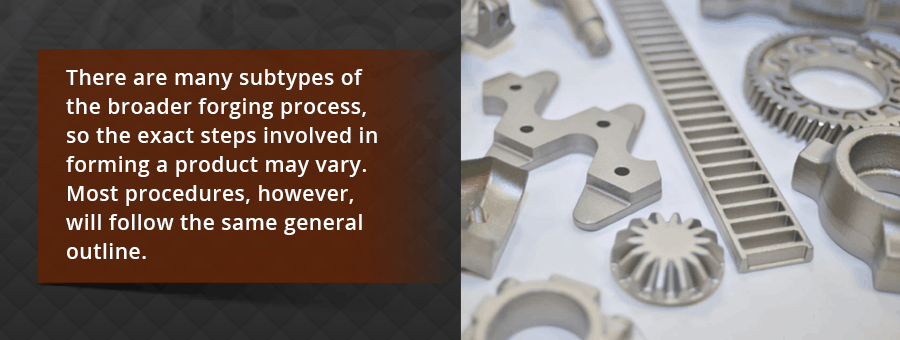
There are many subtypes of the broader forging process, so the exact steps involved in forming a product may vary. Most procedures, however, will follow the same general outline.
- Forging relies on the use of dies to compress and shape metal, so it’s critical to determine what set of tools will be most effective to achieve the desired shape. In many cases, custom die design will be necessary to ensure that the final product aligns exactly to expectations. For larger production runs, this step might include the design and production of multiple dies designed for flattening, forming, or cutting.
- Once planning and toolmaking have been completed, the actual metalworking can begin. First, the billet, or workpiece needs to be cut to size. Once cut, it must then be heated to the proper temperature. Once heated, the billet is ready to be formed.
- At this point, the various forging methods begin to diverge. Depending on the process chosen, the billet may be heated and pressed between two dies or inserted into a molded cavity and compressed. In some cases, the operator will leave the billet at room temperature and work it manually with hammers in a process called cold forging.
- Finally, there may be some necessary finishing procedures. For instance, some dies will produce flashing that must be trimmed.
Learn About Different Forging Processes.
At Cornell Forge, we work carefully to minimize the need for secondary procedures so we can pass those savings on to our customers. The choice of forging method depends on the part being formed. We work with each client to choose the technique that will afford precise, consistent results and appropriate physical properties for their use case.
Forging Advantages
Most components that can be produced via forging could instead be cast. However, forged products offer significant advantages over parts made by casting—especially for applications where strength and durability are paramount. This is because forging fundamentally alters the structure of the metal—in compressing a solid or heated metal, the material undergoes metallurgical recrystallization, which is a beneficial realignment of the metal grain.
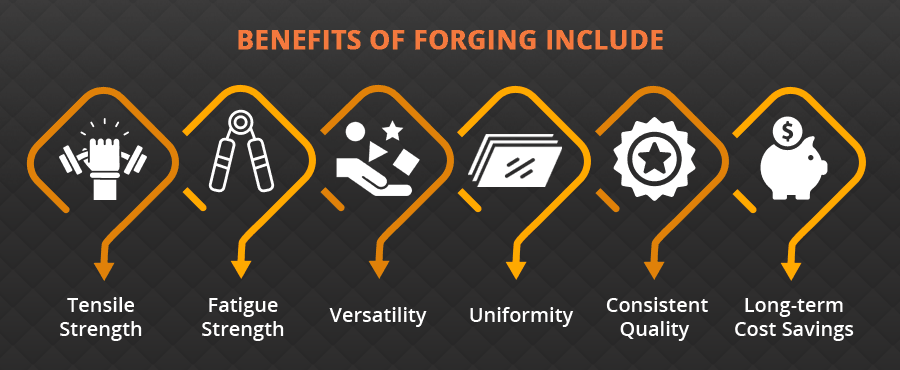
After recrystallization, forged parts have much higher impact and shear strength than raw or cast material. As an added benefit, these improvements in strength can be so pronounced that they counteract the need to use expensive alloys to achieve the desired strength.
Check Out The Different Products We Forge.
Additional benefits of forging include:
- Tensile strength. A University of Toledo study found that forged parts exhibited 26% higher tensile strength than comparable cast-iron components. As a result, forged components can withstand substantially more tension without tearing than other parts.
- Fatigue strength. Forged components have demonstrably higher fatigue strength, allowing for a longer working life versus components made by other methods when observed under the same heavy-duty operating conditions.
- Versatility. Both forging and casting can produce a vast array of products large and small. There’s rarely a reason to choose casting over forging just to obtain a different shape.
- Uniformity. Compared to cast components, forged ones have a more uniform composition and structure, which contributes to their impressive working life.
In addition to surpassing casting on these key metrics, forging also prevents common defects found in casted parts. When casting, it’s common for some percentage of the final parts to have unacceptable levels of porosity, shrinkage, or even voids. Such issues can often lead to having to scrap near fully machined cast parts, thus wasting valuable machining time. None of these problems can occur with forging because the material is never melted and reformed.
This consistent quality is a significant advantage, especially in terms of cost. When a cast part exhibits porosity, it must be scrapped and recast, which incurs substantial material and labor costs. Forging entirely mitigates this risk. Forged parts also lead to long-term cost savings because of their durability, decreasing the frequency with which components fail and need to be replaced.
On the whole, forged parts are tougher than similarly-priced alternatives and are therefore an excellent option for many industrial components.
Industrial Applications
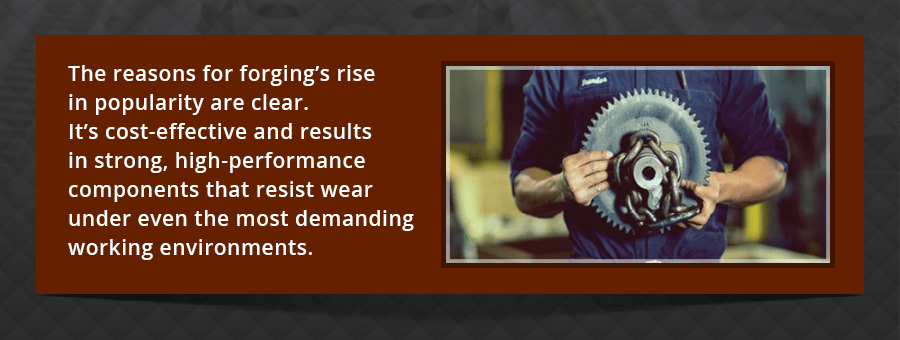
Many industries have begun to recognize the key advantages of forged components. These include:
- Marine and railroad. Parts designed for boat or rail construction and repair are often forged to ensure durability under great tension in harsh operating environments.
- Hand and industrial tools. Tools must be able to withstand a great degree of percussive force without deforming or cracking. Forged metal grants durability that is difficult to achieve through casting.
- High-pressure valves and fittings. There is a need for extremely durable fittings and valves for high-pressure applications that spans many industries. Forged components are often preferable due to their toughness and durability in harsh or high-pressure applications.
- Oil field machinery and equipment. The oil and gas industry presents unique demands for equipment and failures can be extremely costly. Forged metal is safer and reduces the need for expensive shutdowns to replace failing parts.
- Construction, material handling, and mining. Construction sites, mines, and material handling facilities often subject equipment to very heavy loads and rigorous operating conditions. Forged components are often preferred to safeguard against dangerous malfunctions and unnecessary downtime.
On the whole, the reasons for forging’s rise in popularity are clear. It’s cost-effective and results in strong, high-performance components that resist wear under even the most demanding working environments. These benefits can be heightened through careful material selection, which is why Cornell Forge works primarily with high-tensile strength alloys, as well as stainless steel, that maximize strength, durability, and corrosion resistance.
Request Your Custom Forged Products From Cornell Forge Today
At Cornell Forge, we have over 90 years of experience in forging and we use that expertise to guide our clients through every stage of the forging process. We offer design assistance, consultations, and optimization services followed by in-house tooling manufacture, allowing us to work with clients from the very beginning of product planning. Our diverse offerings allow us to work across diverse industries with challenging needs, including military, and medical.
As an ISO 9001:2015-certified company, we hold ourselves to strict quality standards, incorporating stringent process control measures to ensure that every forged part aligns with expectations. What’s more, we work with net or near-net forging processes to reduce waste and cut lead times, meaning that you don’t have to sacrifice sustainability for efficiency.
Our capabilities include forging for stainless steel and steel alloys, alongside value-added services that range from heat treatment to assembly and testing. To learn more about how our custom forging solutions can solve your toughest design challenges, contact Cornell Forge or request a quote today.




